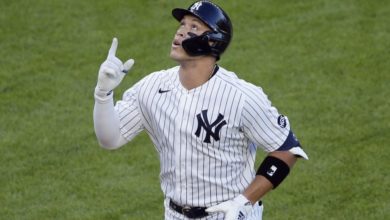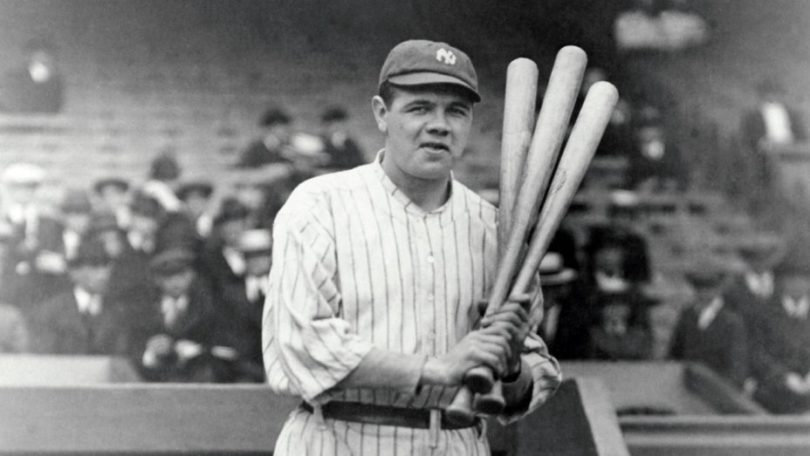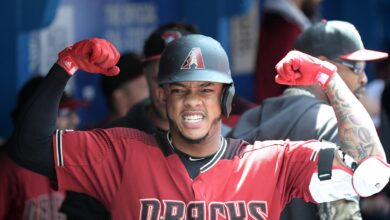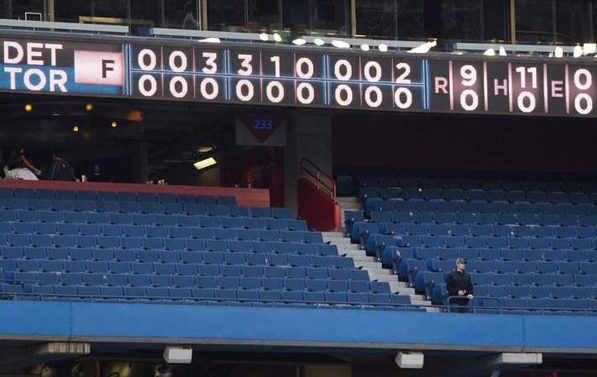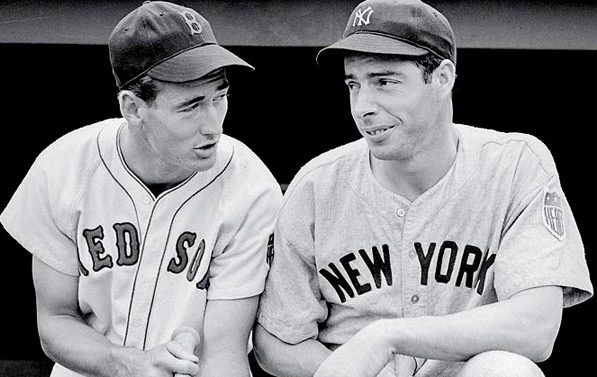
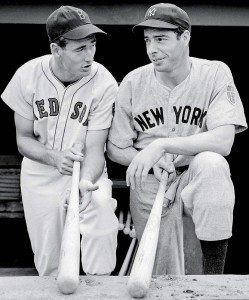
There really isn’t any defined criteria for the MVP award. Arguments over individual success versus team success are always a heated debate. Same goes for pitchers being eligible for the award. Then you throw sabermetrics into the equation, and no one can ever seem to agree on a candidate. For the most part, voters have gotten it right, especially of late. Writers are less likely to hold a grudge these days as they once were. Also, the Cy Young award didn’t come around until 1956, so up until that point, everyone was worthy of the award.
Taking all of that into account, here are some of the biggest so called “snubs” in the history of the award. I have even included some sabermetrics for arguments sake, even though I have some disdain for these stats. These are also listed in chronological order — I’ll leave the rankings up to you.
2002 AL
Winner: Miguel Tejada, Athletics
Stats: .308, 108 R, 34 HR, 131 RBI, 7 SB, .354/.508/.861, WAR 5.2
Should have won: Alex Rodriguez, Rangers
Stats: .300, 125 R, 57 HR, 142 RBI, 9 SB, .392/.623/.1.015, WAR 8.2
The injustice: Statistically, A-Rod dominated Tejada in almost every category, especially WAR. He lead the league in home runs, RBI and total bases (389) and played in every game, as did Tejada. Defensively, A-Rod was better, too. Both shortstops at the time, Tejada’s .975 fielding percentage and 4.63 range factor were inferior to A-Rod’s .987 and 4.73. The deciding factor in the decision? Team success. The A’s tied for the best record in baseball at 103-59, while the Rangers went 72-90, finishing last in the AL West. A-Rod’s $22MM salary, the highest at the time, may have also swayed the writers a little as they surely expected much more than a last place finish. Tejada was definitely deserving, and this wasn’t a huge injustice, but A-Rod was clearly the better player that season in all aspects of the game. This is a classic example of team success trumping individual production.
2000 AL
Winner: Jason Giambi, Athletics
Stats: .333, 108 R, 43 HR, 137 RBI, 137 BB, .476/.647/1.123, WAR 8.7
Should have won: Pedro Martinez, Red Sox
Stats: 18-6, 1.74 ERA, 0.74 WHIP, 284 K/ 32 BB, 217 IP, WAR 10.1
The injustice: Not to take anything away from Giambi’s season, he was awesome, even if it may have been enhanced. He led the league in walks, OBP and OPS+ (187) and lead his team to the postseason, something Pedro’s Red Sox failed to do. That being said, Pedro, in the midst of the steroid era, put together one of the most dominant seasons by a pitcher in modern history. He lead the league in ERA, WHIP, strikeouts, shutouts (4), K/9 (11.8), K/BB (8.9), HR/9 (0.7) and held opponents to a .164 batting average. With the league’s ERA being 4.92, his 291 ERA+ is the highest in modern history, even better than Bob Gibson’s historic 1968 season when he posted a 1.12 ERA. The league’s ERA was 2.99 that year, meaning his ERA+ was 258. Pedro won the Cy Young in 2000, but a fifth place finish in the MVP race was a joke.
1995 AL
Winner: Mo Vaughn, Red Sox
Stats: .300, 98 R, 39 HR, 126 RBI, 11 SB, .388/.575/.963, WAR 4.2
Should have won: Albert Belle, Indians
Stats: .317, 121 R, 52 2B, 50 HR, 126 RBI, 5 SB, .401/.690/1.091, WAR 6.6
The injustice: This one doesn’t make a whole lot of sense. While Vaughn had a great year, Belle’s numbers are far superior in most categories. He led the league in runs, home runs, SLG, total bases (377) and tied for the RBI lead with Vaughn. Was it team success? Nope. Belle’s Indians went 100-44, the best record in baseball, while Vaughn’s Red Sox did make the post season, they won 14 fewer games than the Indians at 86-58. Chalk this one up to Belle’s attitude causing him to miss out on an MVP award.
You could also make a case for Edgar Martinez winning it in 1995. His totals of .356, 121 R, 29 HR, 113 RBI and 1.107 OPS certainly merit it. He led the league in average, OPS and tied with Belle for the lead in runs while also guiding his Mariners to a 79-66 record and an AL West crown. It must have been that whole DH thing.
1991 NL
Winner: Terry Pendleton, Braves
Stats: .319, 94 R, 22 HR, 86 RBI, 10 SB, .363/.517/.880, WAR 6.1
Should have won: Barry Bonds, Pirates
Stats: .292, 95 R, 25 HR, 116 RBI, 43 SB, .410/.514/.924, WAR 8.3
The injustice: Bonds should have eight MVP awards on his mantle instead of his pedestrian-like seven. This is another case of “What were they looking at?” While Pendleton did lead the league in batting average, a .319 mark isn’t something to brag about. Other than that, Bonds was simply better in every category, leading the league in OBP, OPS and WAR. Bonds also won a Gold Glove in left field with a .991 fielding percentage and 13 assists. Pendleton committed 24 errors at third base, good for a .950 fielding percentage. Bonds’ team was better, too. The Pirates went 98-64, winning the NL Central, while the Braves went 94-68, winning the NL East. To be fair, everyone seemed to love the Braves at the time.
1987 AL
Winner: George Bell, Blue Jays
Stats: .308, 111 R, 47 HR, 134 RBI, 5 SB, .352/.605/.957, WAR 5.0
Should have won: Allan Trammell, Tigers
Stats: .343, 109 R, 28 HR, 105 RBI, 21 SB, .402/.551/.953, WAR 8.4
The injustice: Writers dig the long ball, too. Bell had a great season in 1987, but other than home runs, Trammell had the better season. He had the second highest WAR in baseball next to Wade Boggs that season, and he played a premium defensive position, shortstop. Trammell also helped lead his team to the postseason, while Bell’s Blue Jays finished second to the Tigers and out of the playoffs. He was the only AL player to have a 20 HR/20 SB season in 1987 and finished third in batting average. It was a close race, with Bell beating him out 332 to 311, and not a terrible injustice, but Trammell should have won it that year, especially after losing out to his teammate, Willie Hernandez, in 1984.
1972 NL
Winner: Johnny Bench, Reds
Stats: .270, 87 R, 40 HR, 125 RBI, 5 SB, .379/.541/.920, WAR 9.1
Should have won: Steve Carlton, Phillies
Stats: 27-10, 1.97 ERA, 0.99 WHIP, 310 K/ 87 BB, 346.1 IP, WAR 12.4
The injustice: Okay, so this one may cause some backlash. Bench was great, so was his team. He lead the league in home runs and RBI, won a Gold Glove and helped guide the Reds to a 96-59 record, best in baseball that year. He also had Joe Morgan, Pete Rose and Tony Perez. Carlton had Greg Luzinski and Larry Bowa. The Phillies were awful, going 59-97 and finished with the worst record in the National League. Yet, somehow, he managed to win 27 games, or 46 percent of his team’s wins. He lead the league in wins, ERA, strikeouts, ERA+ (182), complete games (30) and had 57 more innings pitched than his closest competitor, Fergie Jenkins (289.1). No other starter won more than four games for the Phillies in 1972. He did win the Cy Young award that year, and while I am almost never in favor of a pitcher winning the MVP award, Carlton’s 1972 season was just too amazing to ignore.
1960 NL
Winner: Dick Groat, Pirates
Stats: .325, 85 R, 2 HR, 50 RBI, 0 SB, .371/.394/.766, WAR 5.7
Should have won: Willie Mays, Giants
Stats: .319, 107 R, 29 HR, 103 RBI, 25 SB, .381/.555/.936, WAR 9.7
The injustice: Dick Groat? Seriously? The Pirates were the best team in the league that year, but Groat wasn’t anywhere near the best player in the league. Look at those numbers again. He did lead the league in batting average, but Mays was a 4-for-4 game away from taking the crown. Maybe you are thinking he was some defensive whiz at shortstop, the position he played. Well, he wasn’t. He committed 24 errors that season for a .960 fielding percentage while Mays won the Gold Glove in center field playing his usual stellar defense. Mays was the premiere power/speed guy at the time, being the only player in 1960 to have at least 25 HR/25 SB. Groat went 2 HR/0 SB. I am all in favor of using team success if the numbers are similar, but this wasn’t even close. Neither was the voting, as Groat beat Mays 276-115, and even the Pirates Don Hoak finished above Mays, collecting 162 votes while hitting .282 with 16 home runs and 79 RBI.
1947 AL
Winner: Joe DiMaggio, Yankees
Stats: .315, 97 R, 20 HR, 97 RBI, 3 SB, .391/.522/.913, WAR 5.6
Should have won: Ted Williams, Red Sox
Stats: .343, 125 R, 32 HR, 114 RBI, 162 BB, .499/.634/1.133, WAR 10.3
The injustice: DiMaggio lead the league in nothing, while Williams lead the league in everything. Williams won the Triple Crown in 1947, leading the league in batting average, home runs, RBI, as well as runs, walks, OBP, SLG, OPS, total bases (335) and OPS+ (215). The Yankees were the Yankees, the writers disliked Williams … and DiMaggio was dating Marilyn Monroe. Nothing else to say really.
1944 NL
Winner: Marty Marion, Cardinals
Stats: .267, 50 R, 6 HR, 63 RBI, 1 SB, .324/.362/.686, WAR 4.0
Should have won: Stan Musial, Cardinals
Stats: .347, 112 R, 12 HR, 94 RBI, 7 SB, .440/.549/.990, WAR 9.1
The injustice: At 105-49, the Cardinals were the best team in baseball, 15 games better than the second place Pirates, so it made sense for the MVP to be awarded to a Red Bird. They just somehow gave it to the wrong guy. Musial’s OPS was 300 points higher than Marion’s, and his WAR was more than double. He also hit almost 100 points better, scored twice as many runs and lead the league in hits (197), doubles (51), OBP, SLG and OPS. Musial actually finished fourth that year, and this is one of the biggest injustices in the history of the MVP award.
1942 AL
Winner: Joe Gordon, Yankees
Stats: .322, 88 R, 18 HR, 103 RBI, 12 SB, .409/.491/.900, WAR 8.4
Should have won: Ted Williams, Red Sox
Stats: .356, 141 R, 36 HR, 137 RBI, 145 BB, .499/.648/1.147, WAR 11.0
The injustice: This. I don’t even know where to start with this one. Another Triple Crown for Williams, another second place finish to a Yankee. Aside from leading the league in batting average, home runs and RBI, he also led in runs, walks, OBP, SLG, OPS, OPS+ (216) and total bases (338). Gordon led the league in strikeouts (95) and grounding into double plays (22). He rubbed the media the wrong way, and they never forgot about it.
1934 AL
Winner: Mickey Cochrane, Tigers
Stats: .320, 74 R, 2 HR, 76 RBI, 8 SB, .428/.412/.840, WAR 4.3
Should have won: Lou Gehrig, Yankees
Stats: .363, 128 R, 49 HR, 165 RBI, 9 SB, .465/.706/1.172, WAR 10.7
The injustice: The Tigers won the pennant, but Gehrig won the Triple Crown. Cochrane wasn’t even the best player on his team as Charlie Gehringer hit .356 with 143 runs, 127 RBI and a .967 OPS. Gehrig, however, was the best player in all of baseball in 1934. Aside from leading the league in batting average, home runs and RBI, he also led in OBP, SLG, OPS, OPS+ (206) and total bases (409). His WAR was also more than double that of Cochrane’s. This one ranks as one of the worst decisions in MVP history.
1925 AL
Winner: Roger Peckinpaugh, Senators
Stats: .294, 67 R, 4 HR, 64 RBI, 13 SB, .367/.379/.746, WAR 2.4
Should have won: Anyone else
The injustice: Seriously, they just seemed to give the award to the second best player on the best team back in the days. Those numbers are laughable for an MVP winner, and the guy wasn’t any better on defense, committing 25 errors in 1925 for a .952 fielding percentage at shortstop — and that was actually one of his better defensive seasons. The Senators were 96-55, had the best record in baseball and Goose Goslin hit .334 with 20 triples, 18 home runs, 113 RBI, 27 stolen bases and a .941 OPS, but Peckinpaugh won the award. Al Simmons of the A’s would have been a great candidate, as well. He hit .387 with 122 runs, 24 home runs, 129 RBI, 1.026 OPS, and led the league in hits (253) and total bases (392). Or how about Harry Heilmann of the Tigers? He lead the league with a .393 average to go along with 134 RBI and a 1.067 OPS. Nope, Peckinpaugh it is.
1913 NL
Winner: Jake Daubert, Brooklyn Robins
Stats: .350, 76 R, 2 HR, 52 RBI, 25 SB, .405/.423/.829, WAR 3.3
Should have won: Christy Matthewson, Giants
Stats: 25-11, 2.06 ERA, 1.02 WHIP, 93 K/ 21 BB, 306 IP, WAR 6.5
The injustice: Remember, there wasn’t a Cy Young award in these days, so pitchers had just as much right to the award as hitters back then. Daubert did lead the league in average, but all of his other numbers were just that, average. Plus, his team was bad. The Robins, otherwise known as the Dodgers, went 65-84 in 1913, finishing sixth in the NL. This was still the dead-ball era, so pitching was the dominant force and no one was better in the NL than Christy Matthewson in 1913. He lead the league in ERA, WHIP, ERA+ (152) and K/BB (4.4). His Giants were also the best team in baseball at 101-51. Matthewson went 373-188 over his 17-year career, ranking third all-time in wins. He also ranks eighth in ERA (2.13) and sixth in WHIP (1.06). He never won an MVP, and this was his year to do so.
1912 NL
Winner: Larry Doyle, Giants
Stats: .330, 98 R, 10 HR, 90 RBI, 36 SB, .393/.471/.864, WAR 5.5
Should have won: Honus Wagner, Pirates
Stats: .324, 91 R, 7 HR, 107 RBI, 26 SB, .395/.496/.891, WAR 8.1
The injustice: Both players put up similar numbers, with Doyle slightly edging out Wagner in most categories except WAR. Doyle’s team was better, too, with the Giants winning the pennant at 103-48 while the Pirates finished second at 93-58. The injustice here is that, at age 38, Wagner was nearing the end of one of the best careers in the history of baseball. To this day, he is considered one of the top right-handed hitters to ever play the game. Even in the twilight of his career, he managed to lead the league in RBI in 1912 and was still one of the premiere hitters in the game. With the MVP award having just started the year before, the writers should have tipped their cap and acknowledged the eight-time batting champ’s contribution to the game by honoring him with an MVP award.


